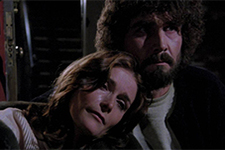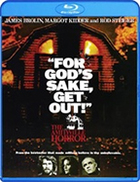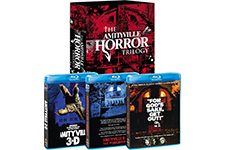The Amityville Horror (1979)
|  Like William Friedkin’s The Exorcist (1973), the film it is most obviously trying to emulate, The Amityville Horror is based on a supposedly true story. Of course, The Exorcist was taken from a fictional book by William Peter Blatty that was inspired by news reports he had read while in college of a preteen boy possessed by a demon; The Amityville Horror, on the other hand, was adapted from a supposedly nonfictional account of a haunting by documentary scriptwriter Jay Anson. Anson’s book, which turned out to be a major bestseller in the late 1970s, chronicles one family’s terrifying 28 days in a haunted house on Long Island. As Anson writes in the afterword to his book, “To the extent that I can verify them, all the events in this book are true.” Of course, many have called into question the validity of Anson’s account. It is, after all, a fairly sensationalistic story, and stories like it tend to draw a strict dividing line between those who believe in them and those who don’t. There is rarely any room for those who might believe that some of it might be true and some of it might be exaggeration. (A 1995 book titled The Amityville Horror Conspiracy by Stephen Kaplan and Roxanne Salch Kaplan, both members of the Parapsychology Institute of America, attempts to prove that the whole thing was, in fact, a hoax.) The 1979 film version, directed by Stuart Rosenberg (Cool Hand Luke), takes the account quite seriously, sticking fairly close to Anson’s book (although it omits some subplots and details and exaggerates others). In December 1975, newly married couple George (James Brolin) and Kathy (Margot Kidder) Lutz and their three children from Kathy’s previous marriage buy a big, three-story colonial-style house at 112 Ocean Drive on Long Island. Although the house looks normal from the front and the rear, the sides of the house are adorned at the top with two slanted, triangular attic windows on either side of a chimney that have the unmistakable menace of glaring, demonic eyes (whoever was the architect of this house must have known that some day it would be haunted). George and Kathy are able to buy the house far under its actual value because, one year earlier, a young man named Ronald DeFeo had shot and killed his entire family there, including his mother, father, and four younger siblings. The narrative chronicles the strange, supposed paranormal events that eventually cause the Lutz family to desert the house, leaving behind all their possessions and never returning. These include a mysterious swarm of flies that attack a Catholic priest (Oscar winner Rod Steiger in an incredibly bad performance) when he comes to bless the house, black slime gurgling up through the toilets, doors and windows mysteriously closing and locking, and a harsh chill felt through the house. Soon, the youngest daughter is speaking with an invisible friend named Jodie who “tells her things,” and in the overwrought climax, blood runs from the walls and something very large attempts to break its way through the basement floor. On its surface, The Amityville Horror is a strictly by-the-numbers, formally competent haunted house thriller. It has the somewhat slow pace of a made-for-TV movie (no surprise that screenwriter Sandor Stern has written numerous TV movie scripts) that is interrupted now and again by some genuinely scary moments, most of which happen at exactly 3:15 a.m., the time at which the DeFeo mass murder occurred. The performances by James Brolin and Margot Kidder are assured and convincing, which helps us believe in their strained relationship—which includes his marrying into a family and having to change his religion to Catholicism—and how it is exacerbated by the paranormal occurrences. In looking back at reviews written during the film’s theatrical release, I was surprised to note that many critics missed (or simply ignored) the obvious and disturbing link the film makes between paranormal horror and domestic violence. In fact, it seems to me that the film, much like Stanley Kubrick’s The Shining (1980), is really more about the deep-seated, primal fear of family members inflicting violence on each other than it is about ghosts and demonic spirits. Consider that the film opens with the most intense form of domestic violence: a son murdering his entire family in cold blood. The film then carries this theme forward by suggesting that the house is somehow possessing George Lutz and causing him to become angry and violent toward Kathy and the children (once again, much like The Shining). The most chilling scene in the film is a nightmare Kathy has in which she dreams that she walks into her daughter’s room and finds George standing over her bloody body with an upraised axe. The axe becomes a recurring symbol of violence throughout the film, as there are numerous shots of George hacking away at firewood outside, even though he has enough chopped to last them through the winter. One gets the feeling that he is simply trying to excise his violent tendencies on the wood, rather than the people with whom he lives, although these sequences build the uneasy suggestions that, sooner or later, the wood will no longer suffice. However, it is not particularly surprising that any social subtexts the film has to offer would be lost in the cavalcade of controversy surrounding the authenticity of the narrative. The controversy helped the movie become a major success, earning over $86 million at the box office in the spring of 1979 (the equivalent of $298 million today) and unleashing a seemingly endless parade of increasingly bad sequels, which at present number 18. The controversy continues to rage, with Ronald DeFeo being turned down for parole and new documentaries, TV episodes, and articles about the events arriving on a regular basis. There will probably never be a final, definitive answer as to what happened at 112 Ocean Drive during the 28 days the Lutz family lived there, but that won’t stop the curious from seeking.
Copyright © 2017 James Kendrick Thoughts? E-mail James Kendrick All images copyright © MGM / Shout! Factory | |||||||||||||||||||||||||||||||
Overall Rating: 

 (2.5)
(2.5)


 The Amityville Horror is available as part of the “Amityville Horror Trilogy” boxset, which also includes Amityville II: The Possession (1982) and Amityville 3-D (1983).
The Amityville Horror is available as part of the “Amityville Horror Trilogy” boxset, which also includes Amityville II: The Possession (1982) and Amityville 3-D (1983).